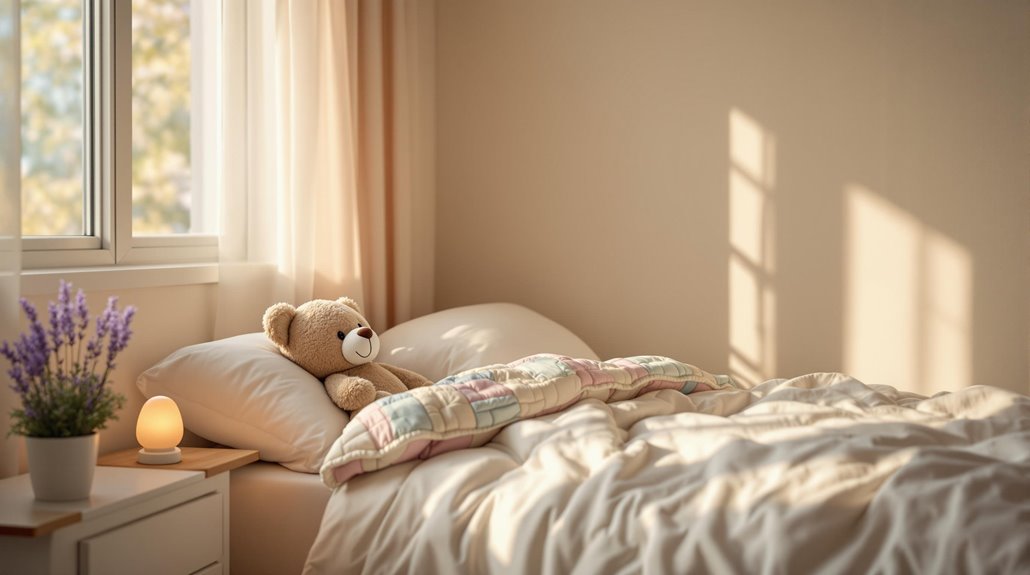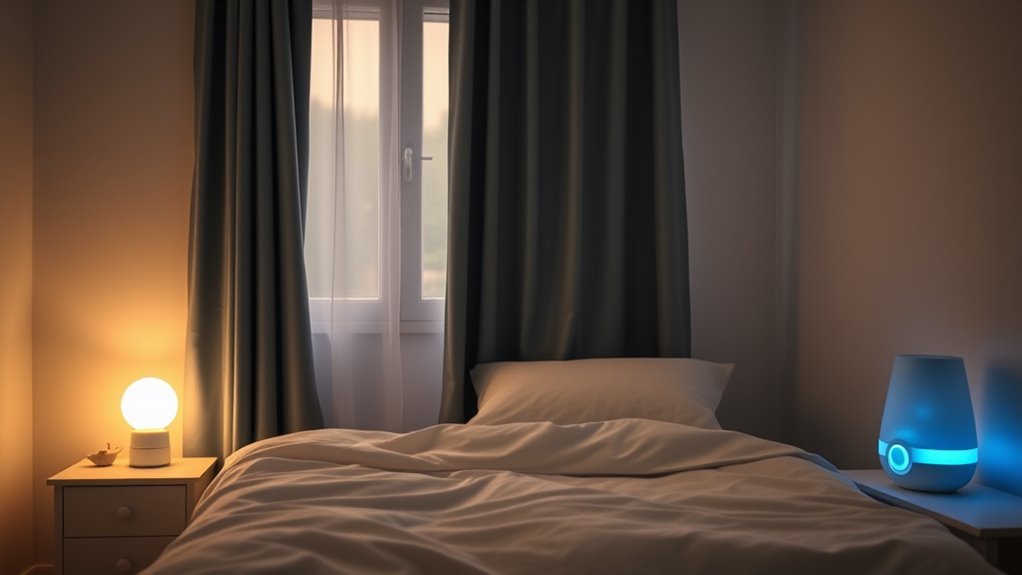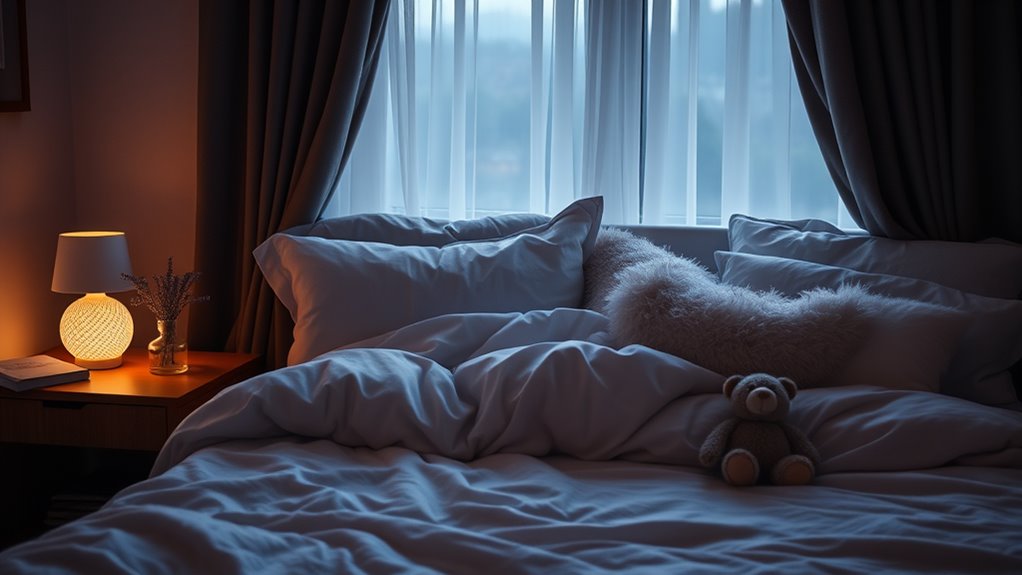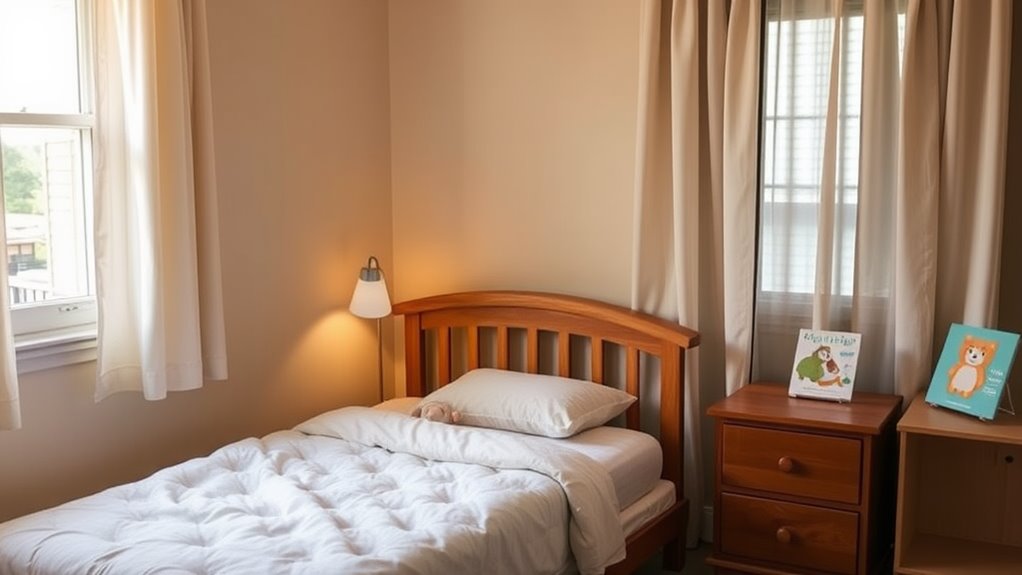
To improve your child’s sleep hygiene, start with a consistent bedtime routine around 20 minutes long, involving quiet activities like reading or a warm bath. Stick to regular sleep schedules to align with their biological clock and regulate sleep patterns. Create a calming sleep environment by keeping the room cool, around 65-68°F, and use minimalist decor with noise-blocking curtains. Limit screen time before bed by encouraging activities like mindfulness or reading. Guarantee comfort with familiar objects and manage stimulants by administering medications in the morning. Follow these tips to discover additional strategies for fostering better sleep habits.
Establishing a Bedtime Routine
Establishing a bedtime routine is essential for promoting healthy sleep habits in children. You can transform those chaotic evenings into opportunities for relaxation and bonding. Start with quiet activities like putting on pajamas or enjoying a warm bath. Most children fall asleep within 20 minutes, provided they have a comforting routine and environment. These simple rituals can be the bedtime rewards your child looks forward to.
Don’t shy away from routine flexibility; adjust the sequence or activities to suit your family’s rhythm. Maybe tonight, a book under dimmed lights or a soothing story fills their imaginations with dreams.
For older children, consider incorporating relaxing activities like listening to music or having a quiet chat. The key is consistency in duration—aim for around 20 minutes—and end at least an hour before sleep. This guarantees sufficient wind-down time.
Remember, the bedroom should be a fortress of tranquility: cool, dark, and free from distractions. Use the trick of soothing scents like lavender to serenely signal that sleep is coming.
Routine flexibility means adapting as your child grows. What works for an infant won’t suit a teenager. By personalizing the routine, you’re teaching them to value their unique needs, empowering both of you with better nights and energized days.
Consistent Sleep Schedules
Bedtime isn’t just a nightly obligation; it’s the cornerstone of healthy sleep habits for your child. Establishing a consistent sleep schedule helps regulate their sleep patterns, aligning with their biological clock. By sticking to the same bedtime every night, even on weekends and holidays, you allow your child’s internal body clock to find its rhythm. This consistency empowers them to maintain a healthier sleep-wake cycle, reducing sleep difficulties and disruptions. Inconsistent sleep times can throw off the balance, making it harder for kids to fall asleep and stay asleep. A regular schedule enhances sleep quality, ensuring they wake up refreshed and ready to take on the day. The key to harmony lies within those daily rhythms and habits. Encourage your child to soak up natural light in the morning to align their circadian rhythms, prompting their biological clock to function efficiently. Exercise during the day can also promote better sleep by reducing feelings of anxiety and tiring the body healthily. Regular sleep times contribute to better sleep quality, helping to foster a sense of security and expectation for your child.
Sleep-Conducive Environment

Creating a consistent sleep schedule sets the stage for the next step in promoting healthier sleep—designing a sleep-conducive environment. Imagine your child slipping into a serene oasis each night, where bedroom decor and sleep accessories harmonize to invite tranquility.
Begin by adjusting the room temperature to a cool 65 degrees, a balance that nudges the body’s natural cooling process. Soft, season-appropriate pajamas complement this, cocooning your child in comfort. Don’t overlook the power of a supportive mattress and pillow combo; they cradle the spine, ensuring restful slumber.
Noise and light are silent saboteurs of serene sleep. Shield your child’s sanctuary from unwanted sounds with noise-blocking curtains or a trusty fan. Darkness is your ally—dim lights as the bedtime hour draws near, and opt for a gentle nightlight only if necessary.
Incorporating a mobility routine before bed can also help relax muscles and prepare the body for sleep, reducing discomfort during the night.
By transforming the bedroom into a sleep haven, you’re laying down the foundation for restful nights.
- Minimalist Decor: Stripped of distractions, the room releases you from chaos.
- Soothing Aromas: Lavender’s scent whispers relaxation into the air.
- Dedicated Space: Reserve the bed strictly for sleep, tethering relaxation to that spot.
- Safety and Security: Trust blooms where feeling safe is paramount.
Managing Screen Time
Steering through the landscape of screen time in children’s daily routines isn’t just about setting rules—it’s about building habits that prioritize restful sleep. Creating screen-free zones is essential; keep electronic devices out of bedrooms to eliminate late-night distractions and interruptions. Store these gadgets in a family room, establishing a technology-free sanctuary that naturally encourages slumber. Set an example by adhering to these guidelines yourself. Implementing technology curfews fosters healthier sleep routines. Encourage your children to turn off screens at least an hour before bedtime. Use alarms or reminders to guarantee consistency, and replace screen time with calming activities such as reading or mindfulness exercises. Mindful breathing techniques are an excellent substitution activity that can help relax the mind before sleep by improving emotional resilience. This helps reduce exposure to the disruptive blue light emitted by screens and diminishes the allure of stimulating content. To further counteract blue light, embrace filters and apps that adjust screens to warmer colors, or use special glasses for protection. Modify devices to “night mode” and consider red light bulbs as alternatives for evening lighting. Limit engaging content to curtail overstimulation, especially violent or social media interactions which can provoke restlessness. By managing screen time effectively, you’re paving the way for your child to experience freedom from sleep disturbances.
Ensuring Comfort

To guarantee your child feels comfortable and secure at bedtime, address their nighttime needs by keeping a favorite toy or blanket nearby.
Prioritize a safe sleep environment by eliminating choking hazards and guaranteeing the room is dark and quiet.
Meeting Nighttime Needs
Meeting a child’s nighttime needs is essential for guaranteeing they get a restful night’s sleep. Start by establishing a consistent nighttime hydration plan and bathroom routine. Offer a small drink of water before bed and guarantee your child uses the bathroom to prevent any nighttime wake-ups.
Focus on making the sleep environment as comfortable as possible. Keep the room at a cool 65 degrees, and use thinner blankets and comfy pajamas to avoid overheating. This comfort helps liberate your child from an uneasy night’s sleep.
Consider the following suggestions to create a balanced and comforting bedtime setting:
- Dim Lighting: Use warm-colored nightlights or keep the room dark to support natural sleep rhythms.
- Noise Control: Minimize disturbances with noise-blocking curtains or a white noise machine.
- Device-free Zone: Remove electronics that might distract or emit light.
- Bedtime Routine: Stick to a routine including relaxation activities like reading or listening to quiet music.
Promoting Safe Sleep
Ensuring your child’s sleep is both safe and comfortable involves a few key practices, particularly when it comes to sleep position and environment.
Start by placing your baby on their back for every sleep time, including naps, enhancing their security until they’re one year old. Choose a firm, flat mattress within a safety-approved crib or bassinet, reinforcing crib safety. Keep that sleeping surface completely flat, avoiding inclines that could obstruct breathing.
To fortify safe sleep practices, eliminate soft bedding, pillows, and toys; these represent potential suffocation hazards.
Also, consider keeping your baby’s crib in the same room as yours for about the first six months. This setup allows for easy monitoring while reducing risks.
Maintain a room temperature between 16-20 degrees Celsius, striking a balance that avoids either overheating or undercooling.
Ditch the loose blankets for a wearable blanket or sleep sack, keeping your baby cozy without the risk.
Skip soft furniture like couches or armchairs for sleeping; they’re no-go zones.
Avoiding Stimulants
Stimulants can greatly impact children’s sleep, especially when they’re managing conditions like ADHD. You might notice your child taking longer to fall asleep, a situation often linked to stimulant medication.
By adjusting stimulant timing, you can lessen its contraction with their natural sleep patterns. A key strategy involves administering stimulants earlier in the day, limiting their impact on nighttime rest. Fine-tuning dosage adjustment can also play a significant role; lower doses might help reduce sleep disturbances while still managing ADHD symptoms effectively.
Here are some empowering steps you can take:
- Embrace the shift: Move your child’s stimulant intake to the morning hours to dodge nighttime effects.
- Monitor mindfully: Regularly evaluate both sleep quality and ADHD symptom control to guide dosage decisions.
- Consider alternatives: If sleep issues persist, discuss non-stimulant options with your child’s doctor.
- Stay proactive: Any negative changes in sleep should prompt a conversation with healthcare professionals.
Appropriate Bedtime Activities

Creating a calming bedtime environment sets the stage for a restful night’s sleep. You can liberate your evenings from bedtime chaos by establishing a consistent routine that leads children to relaxation. Start with soothing activities like reading bedtime stories and playing calming music. Ascertain this routine consists of 3-4 activities, lasting about 20 minutes, to help your child recognize it’s time to wind down. As you create this routine, remember familiar activities provide comfort and ease for both you and your child.
Here’s a simple guide to bedtime activities:
| Activity | Purpose |
|---|---|
| Bath time | Calms the body and mind |
| Reading bedtime stories | Sparks imagination and relaxation |
| Listening to calming music | Promotes a peaceful atmosphere |
Taking control of the evening routine gives you and your child a sense of freedom from daily distractions. Remove toys and electronic gadgets from the bedroom to ascertain it’s a rest-focused space. Encourage your child to bring along a beloved teddy bear or cozy blanket for reassurance. These small, consistent steps promote a liberating bedtime experience, making sleep time welcoming and predictable. As a result, you’ll discover more tranquility in your nightly routine and improved sleep quality for your child.
Regulating Bedroom Temperature
Your child’s comfort during sleep heavily relies on bedroom temperature regulation. By ensuring a room temperature between 65-68°F (18.3-20°C), you encourage a peaceful night’s rest.
Infants may need a slightly warmer environment, up to 69°F (20.5°C), allowing them to sleep securely. Temperature monitoring is essential, as warmer conditions can cause restlessness and disrupt sleep patterns.
Always remember, a space that’s too warm not only affects sleep quality but also raises safety concerns, especially for infants.
To maintain the perfect sleeping environment, consider these liberating strategies:
- Controlled thermometer use: Consistently monitor and adjust room temperature, keeping it in the ideal range.
- Optimal ventilation: Open windows when appropriate to allow fresh air flow and regulate indoor humidity.
- Smart fabric selections: Choose breathable fabrics for both bedding and clothing to aid in natural airflow and temperature regulation.
- Strategic sun management: Close blinds during the day to prevent unnecessary heat build-up inside the room.
Promoting Independent Sleep

Many parents face the challenge of promoting independent sleep in their children. It’s all about breaking free from unwanted sleep associations and overcoming nighttime fears. Start by establishing a consistent bedtime routine. Engage in calming activities like reading or singing a lullaby to signal it’s time for sleep. Maintain regular sleep schedules, even on weekends, to foster stability. Gradually reduce the time you spend at their bedside, encouraging their ability to self-soothe. A comforting transitional object, like a stuffed animal, can help ease the shift to independent sleep. Create a serene sleep environment. Confirm the bedroom is cool, dark, and quiet. While blackout curtains or a sleep mask block light, a gentle night light can alleviate fears of darkness. Minimize distractions by keeping TVs and devices out. Consider getting cozy bedding to make their bed inviting. (Living in the past) can hinder personal growth, and mindfulness techniques help children focus on the present, making it easier to develop healthy sleep habits. Use positive reinforcement to celebrate progress. Implement a reward system with incentives like stickers or small toys for achieving sleep milestones. Stay patient and consistent, especially when returning them to their own bed if they wander. Remember, liberating your child from dependence at bedtime doesn’t just promote sleep—it also nurtures their confidence and independence.













